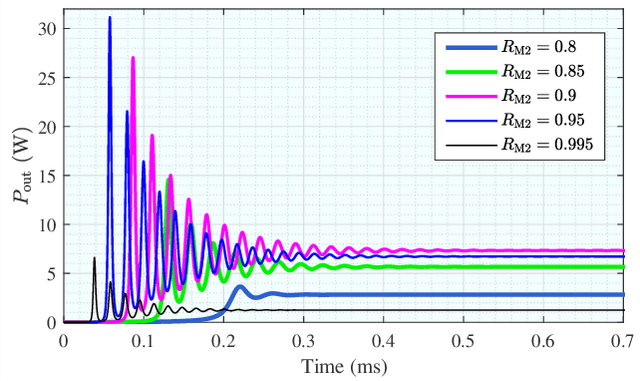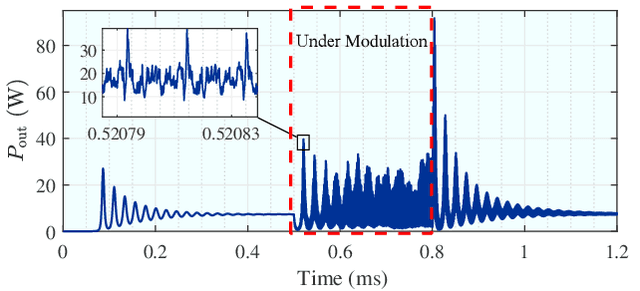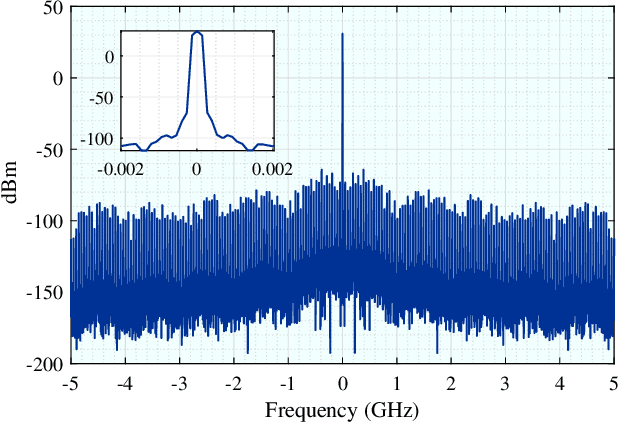Mingliang Xiong
Resonant Beam Enabled Passive 3D Positioning
Dec 20, 2024Abstract:With the rapid development of the internet of things (IoT), location-based services are becoming increasingly prominent in various aspects of social life, and accurate location information is crucial. However, RF-based indoor positioning solutions are severely limited in positioning accuracy due to signal transmission losses and directional difficulties, and optical indoor positioning methods require high propagation conditions. To achieve higher accuracy in indoor positioning, we utilize the principle of resonance to design a triangulation-based resonant beam positioning system (TRBPS) in the RF band. The proposed system employs phase-conjugation antenna arrays and resonance mechanism to achieve energy concentration and beam self-alignment, without requiring active signals from the target for positioning and complex beam control algorithms. Numerical evaluations indicate that TRBPS can achieve millimeter-level accuracy within a range of 3.6 m without the need for additional embedded systems.
Resonant Beam Multi-Target DOA Estimation
Dec 20, 2024Abstract:With the increasing demand for internet of things (IoT) applications, especially for location-based services, how to locate passive mobile targets (MTs) with minimal beam control has become a challenge. Resonant beam systems are considered promising IoT technologies with advantages such as beam self-alignment and energy concentration. To establish a resonant system in the radio frequency (RF) band and achieve multi-target localization, this paper designs a multi-target resonant system architecture, allowing a single base station (BS) to independently connect with multiple MTs. By employing a retro-directive array, a multi-channel cyclic model is established to realize one-to-many electromagnetic wave propagation and MT direction-of-arrival (DOA) estimation through echo resonance. Simulation results show that the proposed system supports resonant establishment between the BS and multiple MTs. This helps the BS to still have high DOA estimation accuracy in the face of multiple passive MTs, and can ensure that the DOA error is less than 1 degree within a range of 6 meters at a 50degree field of view, with higher accuracy than active beamforming localization systems.
Can video generation replace cinematographers? Research on the cinematic language of generated video
Dec 16, 2024Abstract:Recent advancements in text-to-video (T2V) generation have leveraged diffusion models to enhance the visual coherence of videos generated from textual descriptions. However, most research has primarily focused on object motion, with limited attention given to cinematic language in videos, which is crucial for cinematographers to convey emotion and narrative pacing. To address this limitation, we propose a threefold approach to enhance the ability of T2V models to generate controllable cinematic language. Specifically, we introduce a cinematic language dataset that encompasses shot framing, angle, and camera movement, enabling models to learn diverse cinematic styles. Building on this, to facilitate robust cinematic alignment evaluation, we present CameraCLIP, a model fine-tuned on the proposed dataset that excels in understanding complex cinematic language in generated videos and can further provide valuable guidance in the multi-shot composition process. Finally, we propose CLIPLoRA, a cost-guided dynamic LoRA composition method that facilitates smooth transitions and realistic blending of cinematic language by dynamically fusing multiple pre-trained cinematic LoRAs within a single video. Our experiments demonstrate that CameraCLIP outperforms existing models in assessing the alignment between cinematic language and video, achieving an R@1 score of 0.81. Additionally, CLIPLoRA improves the ability for multi-shot composition, potentially bridging the gap between automatically generated videos and those shot by professional cinematographers.
Time-Domain Analysis for Resonant Beam Charging and Communications With Delay-Divide Demodulation
Mar 02, 2022



Abstract:Laser has unique advantages such as abundant spectrum resources and low propagation divergence in wireless charging and wireless communications, compared with radio frequency. Resonant beams, as a kind of intra-cavity laser beams, have been proposed as the carrier of wireless charging and communication, as it has unique features including high power, intrinsic safety, and self-aligned mobility. However, this system has problems such as intra-cavity echo interference and power fluctuation. To study the time-domain behavior of the resonant beam system, we create a simulation algorithm by discretizing the laser rate equations which model the dynamics of the excited atom density in the gain medium and the photon density in the cavity. The simulation results are in good agreement with theoretical calculation. We also propose a delay-divide demodulation method to address the echo interference issue, and use the simulation algorithm to verify its feasibility. The results show that the resonant beam charging and communication system with the proposed demodulator is feasible and performs well. The analysis in this work also helps researchers to deeply understand the behavior of the resonant beam system.
Optimization of A Mobile Optical SWIPT System With Asymmetric Spatially Separated Laser Resonator
Oct 09, 2021



Abstract:High-power and high-capacity simultaneous wireless information and power transfer (SWIPT) becomes more and more important with the development of Internet of Things technologies. Optical SWIPT, also known as simultaneous light information and power transfer (SLIPT), has unique advantages such as abundant spectrum resources and low propagation divergence, compared with RF technologies. However, optical SWIPT faces many challenges in beam steering and receiver positioning/tracking. Resonant beams generated by spatially separated laser resonators (SSLR) have many advantages, including high power, self-aligned mobility, and intrinsic safety. It has been proposed as the carrier of wireless charging and communication. Using resonant beams, mobile electronic devices can be remotely charged and supported with high-rate data transfer. In this paper, we propose a mobile optical SWIPT system based on asymmetric SSLR and present the system optimization procedure. We also determine the boundary of the achievable charging power and communication capacity, and discuss the trade-off between power transfer and information transfer. Numerical results show that the charging power of the optimized asymmetric system is much higher than that of the symmetric system in the previous work, and meanwhile, the channel capacity is kept almost unchanged.
High-Power and High-Capacity Mobile Optical SWIPT
Jul 26, 2021



Abstract:The increasing demands of power supply and data rate for mobile devices promote the research of simultaneous information and power transfer (SWIPT). Optical SWIPT, as known as simultaneous light information and power transfer (SLIPT), can provide high-capacity communication and high-power charging. However, light emitting diodes (LEDs)-based SLIPT technologies have low efficiency due to energy dissipation over the air. Laser-based SLIPT technologies face the challenge in mobility, as it needs accurate positioning, fast beam steering, and real-time tracking. In this paper, we propose a mobile SLIPT scheme based on spatially separated laser resonator (SSLR) and intra-cavity second harmonic generation (SHG). The power and data are transferred via separated frequencies, while they share the same self-aligned resonant beam path, without the needs of receiver positioning and beam steering. We establish the analysis model of the resonant beam power and its second harmonic power. We also evaluate the system performance on deliverable power and channel capacity. Numerical results show that the proposed system can achieve watt-level battery charging power and above 20-bit/s/Hz communication capacity over 8-m distance, which satisfies the requirements of most indoor mobile devices.
Resonant Beam Communications with Echo Interference Elimination
Jun 25, 2021



Abstract:Resonant beam communications (RBCom) is capable of providing wide bandwidth when using light as the carrier. Besides, the RBCom system possesses the characteristics of mobility, high signal-to-noise ratio (SNR), and multiplexing. Nevertheless, the channel of the RBCom system is distinct from other light communication technologies due to the echo interference issue. In this paper, we reveal the mechanism of the echo interference and propose the method to eliminate the interference. Moreover, we present an exemplary design based on frequency shifting and optical filtering, along with its mathematic model and performance analysis. The numerical evaluation shows that the channel capacity is greater than 15 bit/s/Hz.
Mobile Optical Communications Using Second Harmonic of Intra-Cavity Laser
Jun 21, 2021



Abstract:Optical wireless communication (OWC) meets the demands of the future six-generation mobile network (6G) as it operates at several hundreds of Terahertz and has the potential to enable data rate in the order of Tbps. However, most beam-steering OWC technologies require high-accuracy positioning and high-speed control. Resonant beam communication (RBCom), as one kind of non-positioning OWC technologies, has been proposed for high-rate mobile communications. The mobility of RBCom relies on its self-alignment characteristic where no positioning is required. In a previous study, an external-cavity second-harmonic-generation (SHG) RBCom system has been proposed for eliminating the echo interference inside the resonator. However, its energy conversion efficiency and complexity are of concern. In this paper, we propose an intra-cavity SHG RBCom system to simplify the system design and improve the energy conversion efficiency. We elaborate the system structure and establish an analytical model. Numerical results show that the energy consumption of the proposed intra-cavity design is reduced to reach the same level of channel capacity at the receiver compared with the external-cavity one.
Mobility-Enhanced Simultaneous Lightwave Information and Power Transfer
Feb 18, 2021



Abstract:Simultaneous lightwave information and power transfer (SLIPT) has been regarded as a promising technology to deal with the ever-growing energy consumption and data-rate demands in the Internet of Things (IoT). We propose a resonant beam based SLIPT system (RB-SLIPT), which deals with the conflict of high deliverable power and mobile receiver positioning with the existing SLIPT schemes. At first, we establish a mobile transmission channel model and depict the energy distribution in the channel. Then, we present a practical design and evaluate the energy/data transfer performance within the moving range of the RB-SLIPT. Numerical evaluation demonstrates that the RB-SLIPT can deliver 5 W charging power and enable 1.5 Gbit/s achievable data rate with the moving range of 20-degree field of view (FOV) over 3 m distance. Thus, RB-SLIPT can simultaneously provide high-power energy and high-rate data transfer, and mobile receiver positioning capability.
 Add to Chrome
Add to Chrome Add to Firefox
Add to Firefox Add to Edge
Add to Edge